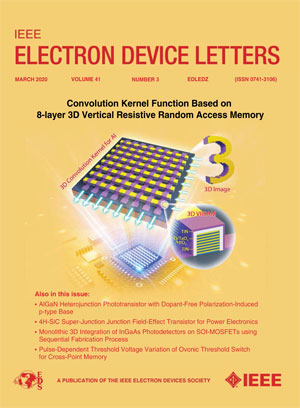3D/2D Core-Shell CsPbBr₃ Microcrystals for Stable X-Ray Detection and Imaging
IF 4.1
2区 工程技术
Q2 ENGINEERING, ELECTRICAL & ELECTRONIC
引用次数: 0
Abstract
Although metal halide perovskite (MHP) materials are promising candidates for direct X-ray detection, the surface and internal defects of perovskite polycrystalline thick films lead to severe noise current and poor device stability. Herein, a phenylethylammonium (PEA+) cladding layer was integrated with 3D CsPbBr3 grains, forming 3D/2D core-shell CsPbBr3 perovskite microcrystals. The PEA+, acting as the A-site cation, is able to passivate the surface defects, while the forming 2D perovskite cladding layer inhibits ion migration within CsPbBr3 grains. The blade-coated polycrystalline 3D/2D core-shell CsPbBr3 perovskite thick film exhibits a reduced trap density from用于稳定x射线探测和成像的3D/2D核壳CsPbBr₃微晶体
虽然金属卤化物钙钛矿(MHP)材料是直接x射线检测的有希望的候选者,但钙钛矿多晶厚膜的表面和内部缺陷导致严重的噪声电流和较差的器件稳定性。本文将苯乙基铵(PEA+)包层与三维CsPbBr3颗粒集成,形成三维/二维核壳CsPbBr3钙钛矿微晶体。PEA+作为a位阳离子,能够钝化表面缺陷,而形成的2D钙钛矿包层抑制了离子在CsPbBr3晶粒内的迁移。叶片包覆的多晶3D/2D核壳CsPbBr3钙钛矿厚膜的陷阱密度从100亿美元降低。{32}\乘以{10}^{{10}}$ cm−3到${4}。与常规CsPbBr3薄膜相比,离子迁移活化能从123 meV增加到210 meV。因此,所制备的钙钛矿x射线探测器具有29,460 ~\mu $ C Gy ${}_{\text {air}}^{-{1}}$ cm−2的高灵敏度和84 nGyair s−1 (50 keV x射线光子能量)的低检测限,且探测器在暗电流漂移低至${4}的情况下保持了长期的工作稳定性。{12}\times {10} ^{-{5}}$ nA mm−1 s−1 V−1。此外,我们将3D/2D核壳多晶CsPbBr3与TFT芯片(${64}\times{64}$阵列)集成在一起,成功获得了空间分辨率为2.5 lp mm−1的小鼠爪子的清晰高对比度x射线图像。
本文章由计算机程序翻译,如有差异,请以英文原文为准。
求助全文
约1分钟内获得全文
求助全文
来源期刊

IEEE Electron Device Letters
工程技术-工程:电子与电气
CiteScore
8.20
自引率
10.20%
发文量
551
审稿时长
1.4 months
期刊介绍:
IEEE Electron Device Letters publishes original and significant contributions relating to the theory, modeling, design, performance and reliability of electron and ion integrated circuit devices and interconnects, involving insulators, metals, organic materials, micro-plasmas, semiconductors, quantum-effect structures, vacuum devices, and emerging materials with applications in bioelectronics, biomedical electronics, computation, communications, displays, microelectromechanics, imaging, micro-actuators, nanoelectronics, optoelectronics, photovoltaics, power ICs and micro-sensors.
 求助内容:
求助内容: 应助结果提醒方式:
应助结果提醒方式:


